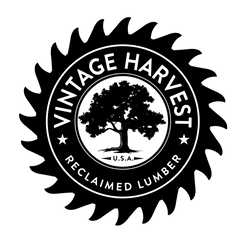How to Install Reclaimed Wood Paneling
Tools Needed:
- Tape measure
- Pencil
- Paint (optional)
- Paintbrush (optional)
- Paint Roller (optional)
- Level
- Power or Table Saw
- Jig Saw or Coping Saw
- Brad Nailer/Hammer
- Nails
How to Install - Vintage Harvest Reclaimed Lumber DIY from Vintage Harvest on Vimeo.
DIY planks are super easy to install with some basic tools. Take your time, lay them out prior to installing to ensure you get a good mix of all the colors throughout your wall or project.
Step 1: Design Your Reclaimed Wood Layout
- Organize and lay out your Vintage Harvest reclaimed wood on a flat surface, such as a floor or large table. Whether you’re designing an accent wall or a reclaimed wood backsplash or a smaller item like a table, you still want to organize the design due to the variations in the reclaimed wood. The layout you choose should resemble the way you would like the wood displayed on your wall or surface. Pick the planks so that each row is the same width, but vary the order of the boards from row to row and vary the length of the board to complement the natural variation of the vintage wood.
Step 2: Surface Prep
- Paint your surface a dark color to conceal any holes in your lumber. (Optional)
- If fastening the reclaimed wood to a wall (like for an accent wall or backsplash), mark your studs after painting, ensuring fasteners penetrate into the studs.
- Remove any outlet or light switch covers. Measure and mark where the covers will be on the lumber. Use a jigsaw or coping saw to cut out these areas so that you can easily re-apply covers after installation.
Step 3: Install
- Install your first row of reclaimed wood. This can be done in a horizontal, vertical or angled fashion (for herringbone or chevron installations). If you are applying horizontally, make sure you use a level. If you are applying at an angle, place your first row at the angle you prefer.
- Hold in place and fasten your lumber with nails. If placing on a wall, use the marked studs as a reference of where to fasten.
- Optional: if you choose to use wood glue or another form of adhesive, apply directly to the back side of your lumber before placing and securing pieces to your surface area.
